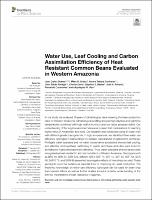Water use, leaf cooling and carbon assimilation efficiency of heat resistant common beans evaluated in western Amazonia
Date
2021Author
Suárez, Juan C
Urban, Milan O
Contreras, Amara T
Noriega, Jhon E
Deva, Chetan
Beebe, Stephen E
Polanía, José A
Casanoves, Fernando
Rao, Idupulapati M
Sustainable development goals
ODS 13 - Acción por el clima
Type
Artículo
Metadata
Show full item recordAbstract
In our study, we analyzed 30years of climatological data revealing the bean production risks for Western Amazonia. Climatological profiling showed high daytime and nighttime temperatures combined with high relative humidity and low vapor pressure deficit. Our understanding of the target environment allows us to select trait combinations for reaching higher yields in Amazonian acid soils. Our research was conducted using 64 bean lines with different genetic backgrounds. In high temperatures, we identified three water use efficiency typologies in beans based on detailed data analysis on gasometric exchange. Profligate water spenders and not water conservative accessions showed leaf cooling, and effective photosynthate partitioning to seeds, and these attributes were found to be related to higher photosynthetic efficiency. Thus, water spenders and not savers were recognized as heat resistant in acid soil conditions in Western Amazonia. Genotypes such as BFS 10, SEN 52, SER 323, different SEFs (SEF 73, SEF 10, SEF 40, SEF 70), SCR 56, SMR 173, and SMN 99 presented less negative effects of heat stress on yield. These genotypes could be suitable as parental lines for improving dry seed production. The improved knowledge on water-use efficiency typologies can be used for bean crop improvement efforts as well as further studies aimed at a better understanding of the intrinsic mechanisms of heat resistance in legumes.
Keywords
Delegation
Sede Central
Is part of
Front. Plant Sci, 12:644010
Status
openAccess
xmlui.dri2xhtml.METS-1.0.item-uri-link
https://doi.org/10.3389/fpls.2021.644010


